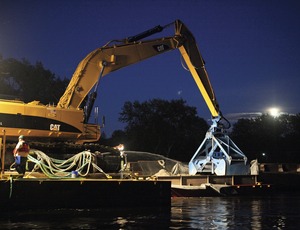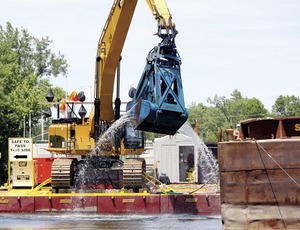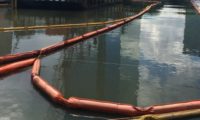

The 315-mile-long Hudson River, which flows in the eastern part of New York state from high in the Adirondack Mountains down to the Battery in New York Harbor, has always been a pivotal waterway in the U.S.—for business and pleasure. Boating, swimming and fishing have long been popular there, but residents who live along the upper Hudson, in particular, know better than to eat the fish.
That's because the river's industrial past has spurred one of the nation's largest and most complex environmental cleanup projects to date: the removal of 2.65 million cu yd of sediment laden with polychlorinated biphenyls, or PCBs, a group of chemicals classified as probable human carcinogens that accumulate in the fish and work their way up the food chain.
The job of reducing the concentration levels of these chemicals in the river and fish is the focus of General Electric's $1-billion dredging project along a 40-mile, heavily contaminated stretch of the Hudson River, from Fort Edward to Troy.
The 10- to 11-year, two-phase project is one of the most complex of its kind in the U.S. It involves roughly 350 workers, more than 70 project-related vessels, heavy machinery and a 110-acre, PCB-dedicated processing and dewatering complex at Fort Edward in the upper Hudson. Despite the scale and scope of the work, questions remain as to whether the effort goes far enough to remove the pernicious toxins.
PCBs have a long history in industry. From 1947 to 1977, GE used oil-based PCBs in capacitors and transformers, which GE manufactured at its Fort Edward and Hudson Falls plants on the upper river.
Over the decades, the plants discharged up to an estimated 1.3 million lb of PCBs into the Hudson. Like other manufacturers, GE was following a common practice along what was then a heavily industrialized river. The company had permits for most of its discharges.
But by the mid-20th century, a growing body of research suggested that PCBs posed a threat to health and the environment. As those findings gained more substantiation, regulators issued fish-consumption advisories in 1971 for the river. The U.S. Environmental Protection Agency bannned PCB production in 1979 and, by 1984, had declared a 200-mile span of the Hudson River a Superfund site. For decades, GE, the government and key stakeholders would tussle over what to do to about the PCB issue—and who should do it.
In 2002, GE agreed to pay for and dredge what were dubbed "hot spot" PCB areas in the river. That same year, EPA issued a record of decision (ROD) for dredging the 40-mile stretch, designated as River Sections 1, 2 and 3, in two phases. The plan still guides the effort today.
In 2007, before the dredging started, GE began building the Fort Edward processing and dewatering complex as well as a separate collection tunnel beneath the river to collect PCBs infiltrating from its Hudson Falls site. (See this sidebar on why PCBs are so persistent in the environment.)
Phase-one dredging began and ended in 2009. Phase two started in 2011 and is expected to be completed by 2017 or 2018. Meanwhile, last June, EPA issued a five-year review of the project so far that shows the cleanup is going according to plans outlined in the ROD. While some groups, including environmentalists, do not necessarily disagree with the findings, they claim the ROD itself is flawed because it does not take into account all of the hot spots and say the effort will leave significant contamination in the river long after project completion. They want the EPA, which oversees the project, to expand the scope and time frame of GE's cleanup. EPA "has issued a final decision, and we're following it," says Mark Behan, a GE spokesman.
Despite the controversy, all parties involved in the cleanup agree the project itself is a major design and engineering feat.
"People who haven't seen the project don't really fully appreciate the complexity of it," says John Haggard, GE executive director of the project. "Prior to getting this under way, there was almost no precedent for this."
The work starts with the excavators, each equipped with clamshell buckets to scoop contaminated debris from what, in some places, is a non-uniform river bottom.
"We have to deal with everything in the river. One day it's a cobble field where there are boulders and course sands and gravel," says Timothy Kruppenbacher, GE operations manager. "Other days, we have to dig over the tops of clay—and you get blocks of clay—or your silts, which we refer to as 'pudding' in the barges."
Each dredge is equipped with GPS technology to help guide the buckets to their targets with what some call "surgically precise" accuracy.
Separate barges loaded with clean sand and gravel follow the dredges to backfill the cuts. Work continues in the dredge zone around the clock, six days a week, during the work season from May through November.
Other barges loaded with contaminated sediment are sent upriver to the Fort Edward processing complex. Along the dredge zone, air, water and noise monitoring systems are in place to alert officials to adverse conditions.
From the roughly 350 project-related workers, including consultants and contractors, to the number of vessels, the amount of equipment and the process itself, the project takes extensive coordination, says Behan. The project must both take into account the dredging operations and accommodate the community that surrounds it, he says. To minimize the noise impact to residents along the river, "whisper-quiet" hospital-grade generators and downward-facing lighting are used on dredging equipment. To track vessels on the water 24/7, GE set up a traffic control center to monitor all the machinery and operations.
Unfinished Business?
In recent years, several U.S. PCB-contaminated waterways have begun evaluation and remediation efforts, though none are tackling such a large section of river as the Hudson project. Wisconsin's Fox River project, for example, started in 2009 and aims to remove or cap 3.8 million cu yd of contaminated sediment. Although that is more than the Hudson project in scope, it only covers a 13.3-mile stretch of the river (ENR 8/3/09 p. 24).
On the Hudson, EPA has project oversight, and GE is the designated potentially responsible party under Superfund. As such, the firm is paying the $1-billion tab for the cleanup. Engineering firm Blasland, Bouck & Lee, now part of Arcadis U.S., and dredging contractor Cashman Dredging and Marine Contracting have been working on the dredging project from the start. The cleanup is on the same schedule as the Champlain Canal, where the processing complex is located.
Using vibracore technology, GE collected 54,000 sediment samples to target where it would dredge in the 40-mile stretch of river. GE says this is one of the largest sampling projects ever conducted in the U.S. The core samples, collected at 80-ft centers, were analyzed in six-inch segments.
"The depth of contamination is established based on what we see in those six-inch segments," Kruppenbacher says. "Our range of cuts is anywhere from six inches to in excess of eight and nine feet in some areas."
After dredging, areas that show PCB concentrations of one part per million (ppm) or less are backfilled with sand and gravel to both encapsulate any residual PCBs and form a substrate for aquatic plant life restoration and habitat reconstruction, says Dave King, director and projects coordinator at EPA Region 2 Hudson River Field Office. Areas that exceed one ppm and hard-to-reach areas that cannot be dredged are capped to isolate the PCBs left behind.
About 60% of the dredging is being done in River Section 1, a six-mile stretch from the former Fort Edward Dam to the Thompson Island Dam, where contamination is heaviest. About 20% of the dredging, which will likely start next year, will cover the next five miles to the North Umberland Dam, or River Section 2. The remainder will hit contaminated hot spots from this dam down to the Federal Dam at Troy in River Section 3.
In phase one, which began and ended in 2009, crews removed 283,000 cu yd of contaminated sediment and debris—exceeding the 265,000-cu-yd target—and capped about 36% of the phase's target area. The depth of contamination, however, was found to be greater than what calculations from the initial core samples showed and greater than what was anticipated in the ROD.
Crews encountered a large amount of woody debris on the riverbed, left behind from long-ago logging operations, that had thrown off depth calculations, Behan says. Once crews removed the debris, GE secured about 4,000 additional core samples to find the proper depth.
Those were not the only murky results of phase one, however. EPA and GE spent 2010 analyzing phase one and devised a plan based on the ROD's engineering performance standards for tackling phase two. The standards set allowable levels for PCB re-suspension in the water during dredging; productivity levels for both the length of dredging time and quantity of material to be removed during the season; and levels for the amount of PCBs left behind after dredging.
Re-suspension was of particular concern as PCB levels were much higher than anticipated after phase one. When levels rose above the 500-parts-per-trillion federal standard for drinking water, contractors halted dredging.
Heavy rains, combined with dredging in several highly contaminated areas at a time, contributed to the rise, King says. To reduce re-suspension risk, dredge passes would be limited to two in phase two, instead of the four usually used in phase one. In some cases, this means deeper dredge cuts are needed, King says.
Another lesson learned was to start backfilling as soon as possible after an area is dredged to better control re-suspension, King says. The phase-two plan also calls for reducing the amount of capping.
Last year, or phase two's first year, started in River Section 1 where phase one left off. Work was delayed until June, however, due to last year's heavy flooding from early spring rains and thaw; river elevation levels can affect the operation.
Kruppenbacher says the river is "worse than a tidal zone because there are five hydroelectric dams between us and the Adirondack Mountains." The dams cycle based on power demand. "In this type of [hot] weather, they'll start releasing right around [noon] till about 6 or 7 tonight," he notes. The cycling can cause elevation levels to fluctuate by one to two feet.
"Before we really got the hang of it, we could find ourselves sitting on a sandbar in no time, because you could be working in 18 inches of water and have 12 inches drop out from under you," Kruppenbacher says. Also, the Great Sacandaga Lake, a flood-control reservoir, affects the Hudson's flow. "If there's no rain in the mountains, their level drops, and that starts constraining how much flow they have in the river," he adds.
While those conditions were factored into the project before it began, the extent of the challenge was underestimated. "We learned a lot about how the river operates in phase one," Kruppenbacher adds.
After dredging, barges filled with the contaminated sediment head to the processing site, operated by Shaw Environmental and Infrastructure. No one piece of equipment at the site is unusual, Kruppenbacher says. "The uniqueness is in the combination of what's here," he notes.
The site includes two barge unloading stations; their cranes drop the contaminated sediment into one of two size-separation process lines that use a series of screens and hydrocyclones to segregate debris. Heavier "debris," which can include bolders, bicycles and anything else the riverbed offers up that day, is separated out from the finer materials and sent to landfills. The finer material is processed through one of two gravity thickeners, which use coagulants and flocculants to turn PCB-laden slurry into solids. The next stop is a dewatering facility with 12 filter presses that turn the solids into sediment "cakes"; then, the cakes are placed in a staging area or loaded into lined railcars headed for out-of-state landfills designed for hazardous materials. To increase productivity, GE added the second off-loading station and second gravity thickener to the site this year.
Meanwhile, before the water is sent back to the river, an on-site, two-million-gallon water treatment plant cleans both the process water and stormwater from the site.
The overall project's next step is to determine the extent of contamination in the floodplain between Fort Edward and Troy. EPA and GE are currently taking sediment samples from the area. "We hope to start remediation in the floodplain while the dredging is going on," King says.
King says the project will achieve its goal of removing "enough PCBs so that the concentrations in the fish go down to the point where they're not an issue as far as human consumption and ecological impacts." Extensive monitoring of those impacts will continue "forever, basically," he adds.
He recognizes the project will not entirely solve the Hudson's PCB issue. "We can't go bank to bank on the entire river," he says, noting there is a point at which that makes no scientific or financial sense. "But it is our hope that, once we get out the contamination from this dredging, the river can heal itself," an outcome that will take decades, he adds.
After project completion, the issue of what to do about unremediated PCBs is in the hands of the project's natural-resource trustees, a group of federal and state agencies charged under Superfund with assessing PCB damage to natural resources.
The trustees already have affirmed that the level of contamination is higher and more widespread than predicted in the ROD and that most of this contamination is adjacent to planned dredged areas. They say the PCB levels remaining after dredging will be "equivalent to a series of Superfund-caliber sites being left behind" and will recontaminate the dredged areas.
"We feel that if the trustees negotiate with GE and GE ends up taking more out, we would certainly support that," King says. "But just how practical that is, is the question."
That response does not sit well with everyone, however. Several environmental groups, including Scenic Hudson, are pushing for more PCBs to be removed.
"Our hope is that GE will be a good corporate citizen," says Althea Mullarkey, policy analyst at Scenic Hudson, which is calling for GE to dredge beyond the ROD-specified area in and out of the dredge zone. "Our hope is that GE will say, 'Our boats are in the river, and our plant is done, and no one can do it better than us, so let's take care of this now.' "
Mullarkey emphasizes that environmental groups are not criticizing the work under way and, in fact, are "impressed with the staff on-site and how they handle things."
Behan says there will always be groups and individuals who feel the project should be larger and those who feel that it should be smaller.
Meanwhile, the agency itself is under fire for taking just 60 days for the review when such reviews for Superfund sites typically take six to nine months. Initially, it was set to last just 30 days but, after prompting earlier this year from Congressman Maurice Hinchey (D-N.Y.), that "such a short time frame would undoubtedly limit what can be reviewed," the agency tacked on 30 days more.
King says the time frame is sufficient. "We are basically reviewing the river on a daily basis, so a lot of the review in a five-year review that you would have to do from scratch we do every day," he adds.
Mullarkey and others argue the review was too rushed to yield meaningful results. She concedes, however, the current dredging operation will leave the river in better condition than it was before the dredging and that "some improvement is better than nothing at all."
But Mullarkey likens GE and the cleanup to a teenager's messy room. "You tell him or her to clean it up, and so they pick up their shoes and socks and maybe a few other things and think they're done. And while they have made a difference, the room is still a mess."
King says that, over time, the river's natural processes will help reduce contamination. "Right now, you can't eat the fish at all. If we can get the [PCB] concentration down to 0.4 ppm in 20 to 30 years, you can eat the fish once every two months," King says. "If we get down to 0.2 ppm, that's one meal per month. At 0.05, it's one meal a week, and that is as far as you will ever get down to," King says, adding that it will likely take about 70 years to reach that point. "So this is a fix for our grandchildren, not us."


Post a comment to this article
Report Abusive Comment